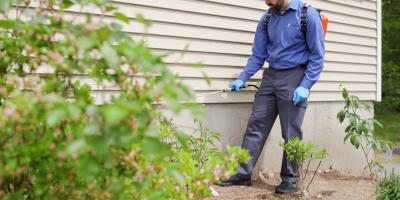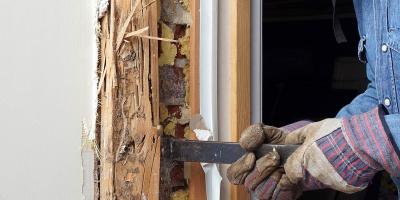Termite Baiting Systems: No better way to control termites!

Understanding Termite Behavior & Biology – Keys to Control:
Termites are social insects that cause more than 5 billion dollars damage to properties in the US each year. Therefore, they are the primary wood destroying insects of structures nationwide, consuming and digesting cellulose (component of wood). Each colony member has a defined role. Termite workers feed and care for the royal court (queen and king), their offspring (nymphs), army (soldiers), and reproductives (swarmers). Queens can churn out 25 eggs per minute, 30,000 eggs/day or more than 11 million eggs per year! These reproductive bursts usually occur in spring and late summer, but they can result in millions of workers in a very short time. Spring is also the time of year when termite swarmers are noticed by homeowners. Subterranean termites (common in New England states) live underground below the frost zone and may be active all year round if their food is not in or above frozen soil.
Like all insects, termites have exoskeletons, and in order to grow, they must shed their old suit of armor after building the “next size up” inside their old skin. Molting or shedding their exoskeleton is a very precarious process leaving them vulnerable and inactive for days. Deaths due to desiccation (water loss) and predation are common in this stage. Social insects are remarkably good at gathering food and concentrating these nutrients in their nests. Scouts, the name for foraging termites, are constantly searching for moist wood and mark these food sources with scent trails to lead other workers to it.
Termite baiting systems have been scientifically proven to be more attractive to termites than wood. Novaflumeron is an active ingredient used in termite baits, and it blocks molting and egg development. Termites cannot detect this growth inhibiter, so workers continue to feed on and gather bait. As foraging ceases, termite queens die of starvation and the colony is eliminated.
All vertebrates (including people) have internal skeletons. We are unable to make or process (digest) chitin (the chief component of insect/arthropod exoskeletons) and, therefore, are not affected by Novaflumeron. Invertebrates that have chitinous exoskeletons could be impacted by exposure, but the way that the bait is delivered (below ground/embedded in soil), and in a food source very few species can consume, it drastically reduces the potential harm to non-target organisms. Termite baiting systems are great examples of highly target specific and environmentally benign pesticide applications. Liquid termite treatments cannot even come close to its overall safety profile.
Baiting vs Liquid Termite Treatments:
In addition to the favorable environmental profile of termite baits, (target-specificity, lack of harm to vertebrates, and protection of other invertebrates by its presentation), there are many additional advantages. Liquid treatments require a lot of physical disruption to properties to facilitate delivery of materials into the soil where termites live under and along the foundation. Concrete slabs (basement floors, patios, driveways, etc.) must be drilled and injected with hundreds of gallons of termiticides. Flowerbeds, plantings, and lawns must be trenched and injected with liquid treatments in a similar way. And for all that effort/disruption, the colony is not eliminated, and termite queens are not always killed. This liquid-insecticide fence is just a barrier to termite attack. It degrades over time, and if disrupted, termites can and will resume their destructive activities. Termites only need a 1/32-inch gap in pesticide coverage to pass through this barrier!
Remedy vs Treating Symptoms:
Baiting termites gets to the heart of the problem by targeting the colony’s astronomical reproductive rate. As with ants, worker termites are expendable and easily replaced. So, treating foragers by spraying materials that kill quickly is not the answer. Such treatments may temporarily halt the visible symptoms, but they are not a cure. The real problem is the relentless foraging by an indominable adversary. The remedy lies in letting termites do what they do best – concentrate nutrients and chemicals back at their nests. Slow-acting termiticides like the active ingredient Noviflumuron prevents termites from molting and growing. These materials are not detectable by termites until it is too late. As workers die, the rest of the dependent colony members die of starvation.
Again, termite baiting systems only target termites and no other arthropods. By its presentation, (underground and impregnated in a cellulose matrix), the bait is highly attractive to termites. Termites prefer this bait to wood! The active ingredient (Noviflumuron) is designated by the Environmental Protection Agency (EPA) as a “least hazardous” material. Termites are not expected to ever develop the ability to overcome it or build resistance to the active ingredient.
In addition to its impressive environmental track record, termite baiting systems continuously monitor for new colonies attempting to damage your home (property), and thereby, delivers peace of mind. For liquid applications there is rarely any follow-up to inspect and maintain the barrier. Any disruption of the barrier (new plumbing or electrical lines, new rooms/additions, addition of mulch, etc.) leaves your home vulnerable to termite attack. The active ingredients in liquid termite treatments vary in longevity, and in some circumstances including soil type, barrier erosion, and UV exposure may degrade more quickly than promised.
Bottom Line:
Regardless of the pest in question, controlling pests requires expertise, experience, and attention to detail. There is no silver bullet or magic pill. When dealing with termites, you will do well by your home and our environment by selecting a termite baiting system as the treatment of choice. As always, we at JP Pest Services are committed to providing the very best services and materials we can for homes and businesses. JP Pest Services is ready to meet whatever pest control challenges you may have!



